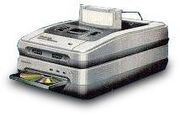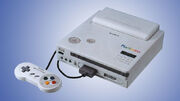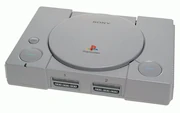|

One design for the SNES CD-ROM was an add-on, akin to the Sega CD for the Genesis/Mega Drive.
The SNES CD-ROM was a planned CD drive for the SNES, similar to the Sega CD. It was developed by Nintendo together with Sony. Eventually the SNES-CD became the standalone Play Station, which took both SNES cartridges and CD-ROMs. However, Sony wanted the full rights to all games published for the SNES CD, so Nintendo instead went with Philips. One day after the Play Station announcement at CES 1991, Nintendo revealed its partnership with Philips.

Another design for the unit. This one was a standalone device, containing both Super Famicom hardware and the Super Disc CD drive.
Sony and Nintendo attempted to repair relations between each other, and in the end, Sony was allowed to continue development on SNES-compatible hardware. However, Sony decided later to create its own, competing console based on the Play Station. This eventually became the current Sony PlayStation. Philips' version of the SNES-CD later became the infamous CD-i.
History
Nintendo first courted Sony to develop a CD-based console in 1988, after both Sony and Philips had pitched their ideas to Nintendo. Nintendo decided to work with Sony, and development resulted first in the SNES-CD, a CD drive attachment for the SNES, and later the Play Station, a console that took both SNES cartridges and CD-ROMs. The Play Station was shown at the 1991 Consumer Electronics Show.
However, Sony's contract with Nintendo gave them the full rights to every game published for the device, so Nintendo then went with Philips. The deal was announced one day after the Play Station announcement.

This was the console that Nintendo inadvertently created - the Sony Playstation. It dominated the 64-bit era, trouncing Nintendo's own console, the Nintendo 64. Without their contributions it may never have been released, and Nintendo would have never gained its strongest rival.
Though Philips continued to work with Nintendo, Sony and Nintendo tried to make up with each other, and Nintendo eventually agreed to allow Sony to produce SNES-compatible hardware. Miffed by Nintendo's abandonment, Sony instead took the Play Station and turned it into its own standalone console, one which would eventually beat Nintendo's machine in the 64-bit era.
Nintendo then broke its deal with Philips, leaving itself with no CD drive in development. Philips was allowed to continue development on the device and, as appeasement, allowed Nintendo-branded games to be published on it. This device became the CD-i, an "interactive CD player" more meant for simple educational titles than for full games. Nevertheless, Nintendo games were made for the CD-i, and while generally liked at the time by reviewers, they eventually became highly unpopular, taking the CD-i's reputation down with them.
